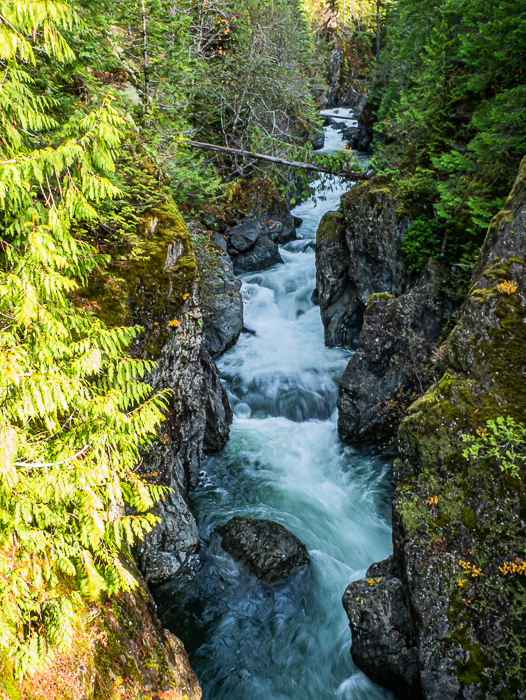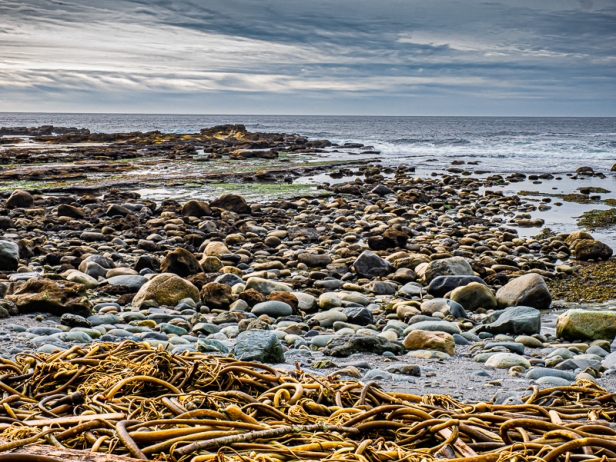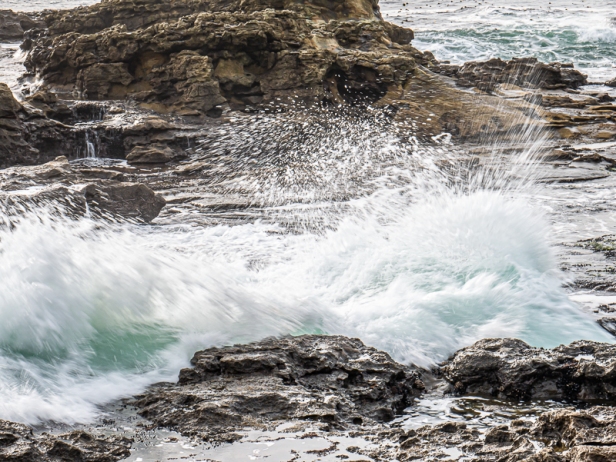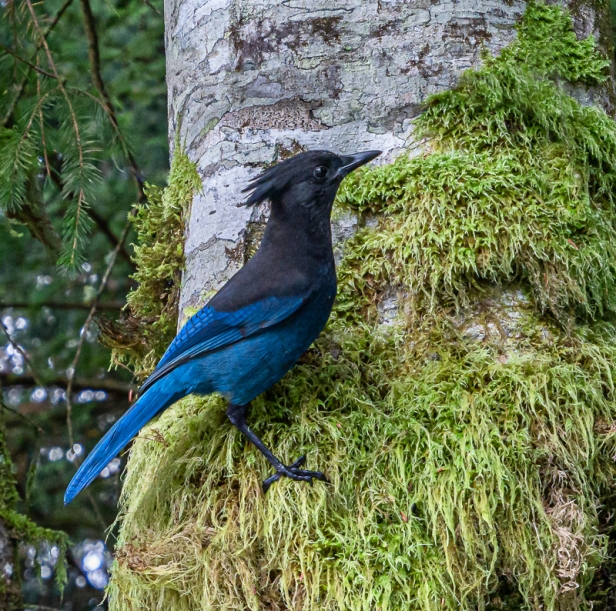
24 October 2019
It is bigger than Belgium, much bigger than Crete, about the same size as Taiwan, and nearly as big as Sri Lanka. Surprisingly it’s quite a bit smaller than Tasmania, which looks tiny because it’s dwarfed by the Australian mainland. Vancouver Island however, sixty kilometres (37 mi) off the coast of Canada, is still pretty substantial. At 460 kilometres (286 mi) long, and 100 kilometres (62 mi) wide it’s the largest island on the west coast of North America. Its sparse population is only 870,000. More than half live in the cities of Victoria and Nanaimo. The rest is pretty much empty.
The west coast of Vancouver Island faces the open Pacific Ocean. It’s a wild uninhabited land with a couple of very small communities each tucked safely in at the end of a long inlet. The island has a ridge of mountains down the middle making any trip from the east coast to the west challenging. If you want to get all the way to the west coast where the Pacific comes crashing against the shore there are only three ways by land. One way is the Pacific Rim Highway from Parksville to world-famous Ucluelet and Tofino, a tortuous road that winds over the spine of the Vancouver Island Mountains. A second way is to drive up the west coast from the city of Victoria at the south end of the island on the West Coast Road as far as Port Renfrew.
Last October on a fine fall day in a world that’s all soft blue-grey sea and distant blue land we travelled by ferry
from Vancouver, zigzagging over the water for 1.5 hours through the Southern Gulf Islands to Nanaimo, and then drove south to Duncan. We have a friend who lives in Duncan and together we took the third way to the west coast: we crossed the mountains on Pacific Marine Road from Duncan to Lake Cowichan to Port Renfrew. It’s a twisty winding former logging road with a backdrop of mountains threading its way through tall whispering trees and careening rivers and waterfalls.
Close to Port Renfrew we stopped Pacheedaht Beach, a gravelly two kilometres long and protected from wide open ocean swells. The quiet beach is littered with logs, and driftwood, and the bright leaves of autumn.


We walk and explore and rest under the thin fall sun and pale sky.
I’m busy photographing

this
and completely miss the little mink that calmly walks up the beach past Don and Surati. It’s that kind of place.


I’m into details: the foliage of the Douglas-fir,
the still dew-damp grasses at the edge of the beach,
and the way driftwood and sand and barnacles are nature as art.

After a time we returned to the car and drove further down the road to the trailhead of the multi-day Juan de Fuca Trail, and hiked into Botanical Beach. It’s a three or four kilometre shady loop trail through a forest persistent enough to withstand the wild west coast weather,

and hiding such beauties as lace lichen,
draped all over the trees like shaggy wizard hair,
and about which my friend Lynn at Bluebrightly has this to say:
Being with this lichen, I perceive a ghostly grace. I hear water splash in the distance, feel cool air on my face. I sense movement, a persistent swaying back and forth across space and time. There is attachment too, in the twirling strands suspended from branches and twigs. If I tug lightly, I sense the rightness of the attachment; the lichen knows its place and resists removal.
Further on I’m stopped by an entire high-rise community of mushrooms on a tree,
and the bright presence of Amanita.
Amanita is both toxic and hallucinogenic. Way back at the dawn of time it is believed that during the long, dark, cold northern winter, maybe around the time of the shortest day, the Shamans of Siberia dried them and delivered these little red and white gifts through the openings in the roofs of the homes of the snowbound villagers. Perhaps after indulging they hallucinated flying reindeer. Who knows? It seems as good an explanation as any for the origin of our rather bizarre and puzzling Christmas traditions.
The forest comes right to the edge of the rocky shore


and then at last we were on the beach.
The beach is a rock shelf,
full of tide pools teeming with marine life. But it was the bullwhip kelp that got my attention. The kelp is a different kind of forest that survives beneath the ocean’s roiling waters until it breaks away and is washed up onto the shore. In the summer it grows up to ten inches per day and can reach a length of 120 feet, and these underwater groves provide sanctuary for all kinds of small marine animals. Also it’s edible, and appears as an ingredient in many products, being used especially to thicken ice cream, salad dressings, hand lotion, and household paints. Who knew?
The kelp was everywhere, strewn along the beach at the high-tide level, snarled around old tree roots and scrambled piles of smooth driftwood, tangled in great mounds like a marine version of medusa’s hair.

Walking further onto the beach and into the weather we look across the water to the Olympic Peninsula in Washington State.

There’s a road and a hiking trail that make for easy access to the beach, and the land in the distance gives some protection from the open ocean. But still, this is a wild lonely place where the inexorable ocean rules,
always moving in, and then out, and in again, accompanied at times by giant storms and frequently by wind. Even the rocks eventually succumb to the relentless influence of the sea.

Back out through the quiet forest a blue jay greeted us on arrival at the car.
We stopped at Tomi’s Home Style Cooking in Port Renfrew for coffee and a much-needed hot snack, and on the way back to Duncan we stopped at the delightfully and aptly named Fairy Lake where a fearless little tree grows from a partially submerged nurse log.
It was a fine day out exploring a tiny part the southern end of this wild and rugged island of quintessential west coast wilderness.

Next post: swinging over to Japan – a dragon festival at Kyoto’s Kiyomizudera Temple.
All words and images by Alison Louise Armstrong unless otherwise noted
© Alison Louise Armstrong and Adventures in Wonderland – a pilgrimage of the heart, 2010-2020.

Beautiful experiences.. beautiful photos.. enjoyed reading your blog. 💜
LikeLiked by 1 person
Thank you so much Rojeena. ❤
Alison
LikeLiked by 1 person
One of most favorite places in the world. Stunning photos Alison.
LikeLiked by 1 person
Thanks so much Cindy. One of our fave places too. So lucky to live in the PNW.
Alison
LikeLike
The very best version of wild, Alison! So much beauty! That lovely mink and the kelp, like an alien being. Huge lungfuls of air! Fabulous 🙂 🙂
LikeLiked by 1 person
Thanks so much Jo. Oh yes – the best version of wild. We are so lucky to live so close to wide open wilderness – and so much of it! I’d seen bullwhip kelp before of course, but never quite like this, never such huge piles of it.
Wish I’d seen the mink 😦
Alison
LikeLiked by 1 person
Really wonderful. The detail gets me every time.
LikeLiked by 1 person
Thanks so much Tracey. I do love to look at the details. (If you follow the link to Lynn’s blog you’ll see lace lichen in the kind of detail you’ve never seen before. Just beautiful.)
Alison
LikeLiked by 1 person
A gorgeous part of the world. Thanks for a piece of home!!
LikeLiked by 1 person
My pleasure Darlene, and yes, a gorgeous part of the world. So lucky to be able to call it home.
Alison
LikeLike
Alison, your gorgeous photos never cease to amaze me. From the Doug Fir to the Amanita – they’re stunning. Of course the little mink stole my heart. You truly captured the wildness and the beauty. ~Terri
LikeLiked by 2 people
Thank you so much Terri. It was a lovely day for photographing, from the little details to the big picture. I wish I’d seen the mink 😦
Alison
LikeLiked by 1 person
Well now another reason to visit and see more…it’s beautiful and magical ☺️🤓 sending you and Don joy for a fun day ~ hugs Hedy 🤗
LikeLiked by 1 person
Oh yes! The west coast of the island is magical. Well the whole island is. You will love it. Joy back to you. We have sunshine! ❤
Alison xo
LikeLiked by 1 person
Enjoy every moment ☀️🤗❣️
LikeLiked by 1 person
Paradise in photos!
LikeLiked by 1 person
Paradise indeed. I feel so lucky to live in this part of the world.
Alison
LikeLike
Lovely photos of our home island. Reminding me one more time of the wondrous land we live on. Thanks!
LikeLiked by 1 person
Thanks so much Keith. A wondrous land indeed. So lucky to live here. Are you here ATM?
Alison
LikeLike
Alison – your words and photography are both so beautiful, and WOW – that wave with the vivd green – it all makes such an inviting story for Vancouver Island. I’m putting it on the wishful travel list in my mind. I especially loved the way you made the isolation and ruggedness so very appealing. Wonderful. Thanks – Susan
LikeLiked by 1 person
Thank you so much Susan. It’s a really wonderful place, and so typical of this part of Canada. Wild and rugged and empty.
Alison
LikeLiked by 1 person
What gorgeous coastline! Loved the contrast of full landscape and close-up photos — especially the mushrooms! It all makes me yearn for cooler fall days at the beach. Thanks for this escape! ~K.
LikeLiked by 1 person
Thanks so much Kelly. The west coast coastline is pretty impressive, and remote. I went to Ucluelet/Tofino a few years back, before I had a camera, and it’s *really* wild there. I’m not yearning for cool fall days – we’ve hardly even got summer this year 😦
Alison
LikeLike
I’ve heard of botanical gardens, but never a botanical beach. I looked on the map and saw that it’s next to Botany Bay – aha! Just the idea forces me to think about the plants growing in the intertidal zone differently: they can be a botanical garden, too. Cool.
It amazed me the first time I looked into traveling on Vancouver Island and found out how hard road trips are there. That does speak to the wild factor! Your drive over the mountains must have been beautiful. I like the sense of pilgrimage that must result from a trip requiring a ferry ride, a drive over the mountains, and then a hike before you reach your destination. A mink, that’s amazing! But your driftwood photos are beautiful so you didn’t really miss anything. 😉 The mushroom photos are fabulous, too, and the tree reflections in that puddle – sweet! Your description of Bullwhip kelp is great and the tangled mound in front of the isolated rock with the trees – wow! What fun it is to see your view of the Olympics. A gorgeous image, that one! But those green waves – and the jay!! I love both. The softness of the Fairy Lake photo is lovely. Finally, of course, many thanks for the extensive mention. 🙂 Very kind of you. Enjoy the rest of your weekend!
LikeLiked by 1 person
Thank you so much Lynn. It was a good fun photography day – lots to look at and capture (except the mink 😦 ) Don said it just walked right by them, not remotely concerned. Oh well. Another time maybe.
The drive was beautiful. Then the beaches such fabulous places to explore. And then I had so much fun making art from the driftwood photos in Lightroom.
I think the Fairy Lake photo is just about my favourite of this collection, but also love the two below “Olympic Peninsula in Washington State.”, and yeah the green waves.
That jay was wonderful – hopping here and there, in shadows, on the ground, too far away, and then suddenly alighting on that tree. Lucky.
And you’re welcome! I loved your Lace Lichen post.
Alison
LikeLiked by 1 person
Yes, I can see the joy of photography in this post! 🙂
LikeLiked by 1 person
Such beauty!
LikeLiked by 1 person
Yes indeed. I love the PNW.
Alison xox
LikeLiked by 1 person
What a place, Alison. I briefly ventured to Vancouver Island to retrieve a rollaboard bag… an activity that makes me seem like a drug mule but I swear it was 100% honest! Still, would love to return one day. If nothing else for the great ferry ride on the way back.
Fabrizio
LikeLiked by 2 people
Oh it’s such a beautiful place, and the ferry ride! I’ve ridden that ferry many many times and it’s always a pleasure especially on sunny days. We saw a pod of orcas once. The ferries always slow to a crawl when there are orcas about so as not to disturb them. Vancouver Island is definitely worth a visit – so many beautiful places there.
Alison
LikeLiked by 1 person
Absolutely fabulous photos Alison, some of those are competition-winning surely? Love the lake views and reflections. Vancouver Island is such a wonderful place isn’t it? We loved visiting but didn’t get far from Victoria as you did. Brilliant.
LikeLiked by 1 person
Thank you so much Jonno. I’m not sure about competition-winning photos, but I was pleased with them. Hope you get back to Vancouver Island one day and explore more. It’s quite spectacular.
Alison
LikeLiked by 1 person
Love to make it back there someday.
LikeLiked by 1 person
What a fabulous post – thank you for sharing this lovely journey. Canada is one of my favourite places to visit and let’s hope it won’t be too long before we can make that long haul once again. Meantime we will soak in your beautiful words and photos and just dream……
LikeLiked by 1 person
Thank you so much Alison. I’m glad you enjoyed it. I hope you get back here one day. And I’d like to go in the other direction, I’m overdue for a trip home, but obviously that will have to wait for a bit. One day . . . . .
Alison
LikeLike
I’m happy that during the pandemic I see a lot of posts about Mother Nature’s beauty. All of the photos really make me want to take a similar excursion, out of Jakarta for a few days to reconnect with nature: feeling crisp fresh air on my face, listening to the sound of chirping birds, hiking through a gentle breeze, and marveling at a verdant tapestry as far as the eye can see. Ahh.. Love this post, Alison!
LikeLiked by 1 person
Thanks so much Bama. I’m glad you enjoyed the post, and that at least virtually you got to reconnect with nature a little. Can you get out of town for a few days? Is that possible? We’re lucky it’s so accessible here in Vancouver.
Alison
LikeLiked by 1 person
Actually I can, and I’ve been mulling the idea of taking one or two days off just to go somewhere out of town. Or even go to one of the small islands off the north coast of Jakarta. We’ll see.
LikeLiked by 1 person
Do it!
A.
LikeLiked by 1 person
First of all, your nature photos are as gripping as always, and seeing you sprawled on the sand reminded me that great photos require some effort!
I have so, so much more exploring to do on the west coast. We’ve covered much of the North American landmass, parts of it deeply, but the Pacific Northwest and western Canada need much more time than we’ve given them to date. We are slowly setting the stage for that, having just rented a very small apartment in Colorado as a base for western road trips (and granddaughter snuggling!) and we’ve added an additional western draw as of yesterday as our youngest son moved to San Francisco! Can’t wait to use both locations as bases for new travels.
LikeLiked by 1 person
Thank you so much Lexie. Oh I’m always sprawled on the ground lol. Too bad my knees aren’t what they used to be.
I do hope you get to the PNW! It’s so amazing here! Sooooo much wilderness, so much empty untouched land. And if the border ever opens again we could meet and that would be even more fabulous.
Alison
LikeLiked by 1 person
That would be the cherry on top! 🙂 Someday …
LikeLiked by 1 person
My kind of a place! I’m on my way, just need to finish packing my camera bag. If only we could travel but thanks to your beautiful photos and prose I can visit from my armchair. Thank you.
LikeLiked by 1 person
Thank you so much Jen. I’m glad you enjoyed it. I do hope you get here one day – it’s a really special part of the world.
Alison
LikeLike
oh how beautiful, how calming! Just what we need! and a mink!!!
LikeLiked by 1 person
Thanks Danila, glad you enjoyed it. It’s a really spectacular place.
Wish I’d seen the mink 😦 next time . . . .
Alison
LikeLike
Gorgeous. Thank you.
LikeLiked by 1 person
Thank you so much Carol, my pleasure.
Alison
LikeLike
Wow – these pictures are so great! What a beautiful place. I can’t wait for some more freedom after COVID to go travelling!
LikeLiked by 1 person
Thanks so much dollar queen. Re travelling – me too!
Alison
LikeLike
Mmmmm this looks like pure bliss. Nature at its finest. Gorgeous photos Alison.
Peta
LikeLiked by 1 person
Thanks Peta. Yes, pure bliss. I do love the PNW for its forests and empty wildness.
Alison
LikeLike
Alas, we were all set to spend a week on Vancouver Island at the end of the month, but Covid got in the way. We actually use another route to the west coast: starting on the same route to get to Tofino, we stop at Port Alberni and take a boat from there. (In this case, a dive boat to a lodge halfway up Barkley Sound. We’ve made it as far as Bamfield via that method.) In any case, lovely PNW countryside.
BTW, I like those detailed shots too. I especially like the mushroom high rise. And if you think kelp is interesting piled on the beach, you should see it underwater, looking upward on a bright, good visibility day. Magical.
LikeLiked by 1 person
Thanks so much Dave. That trip to Port Alberni and then by water *sounds* amazing (no pun intended 🙂 ) – you had me looking at the map to figure out where you meant.
I would love to see that kelp underwater but, being an Aussie girl there’s not much that will get me in Canadian waters. Too darn cold for me 🙂
Alison
LikeLiked by 1 person
Well, if you find yourself in the neighborhood, a passenger/freight boat, the Lady Rose, makes the run between Port Alberni and Bamfield as a day trip, or you could conceivably overnight in Bamfield and come back the next afternoon. It’d be a long run but picturesque, with the chance of seeing whales, bears on shore, etc. Check their web site for more details.
LikeLiked by 1 person
Sounds fabulous!
LikeLike
This is so awesome.
LikeLiked by 1 person
Thank you.
Alison
LikeLike
Fabulous detail shots in this post! I love the colors and textures.
LikeLiked by 1 person
Thanks Mo. I do love this part of the world. If I can’t travel it’s a pretty nice backyard to hang out in.
Alison
LikeLiked by 1 person
Wow, it looks extraordinary Alison! hope to make it there next summer!!!
LikeLiked by 1 person
It really is. I hope you make it here!
Alison
LikeLiked by 1 person
Amazing landscapes.
LikeLiked by 1 person
Thanks rabirius.
Alison
LikeLike
One of my favourite places in the world! Great capture of the mink. I think you’re on to something about the relationship between the Amanita mushroom and flying reindeer…too funny!
LikeLiked by 1 person
I’m so sad I missed the mink 😦 I love encounters like that.
I’d heard of the amanita story before – years ago I read an article about the origins of our Christmas traditions and they pretty much all (including “Santa” being dressed in red and white) come from the ancient indigenous winter solstice traditions co-opted (including the approximate date) by Christianity. It’s really a common story of religious syncretism that’s been buried in the west, unlike in Latin American countries where there’s a very obvious blending of indigenous and Christian beliefs and traditions. Oops sorry for the history of religion lecture lol.
Hope you’re enjoying our wonderful summer weather – finally!
Alison xo
LikeLiked by 1 person
Don’t be sorry. I love the history of religion lecture; so fascinating.
We’ve been taking full advantage of the great weather and local travel—got back from 7 days of backpacking in Chilcotins and now have been swimming at our local beach everyday. We head to Quadra on Saturday for a 5 day kayaking trip. I’m so grateful for all the beauty on this province. Eventually I’ll get to writing about these trips.
Sounds like you and Don are enjoying summer in Vancouver. Have fun!
LikeLiked by 1 person
We are thanks. And looking into a little local escape ourselves – perhaps some camping/hiking on one of the islands. Have a fabulous time on your kayaking trip!
A.
LikeLiked by 1 person
i’m doing some research on botanical beach for a school project at UBC and i stumbled upon your blog. it gave me a much needed rest from school, and an opportunity to connect through your words to the natural beauty of vancouver island. thank you, thank you!
LikeLiked by 1 person
Oh how wonderful. You made my day. I’m so glad you enjoyed it. I do love creating this blog, and it’s extra special when my words and photos reach across cyberspace and brighten someone’s day. You’re welcome!
Alison
LikeLike